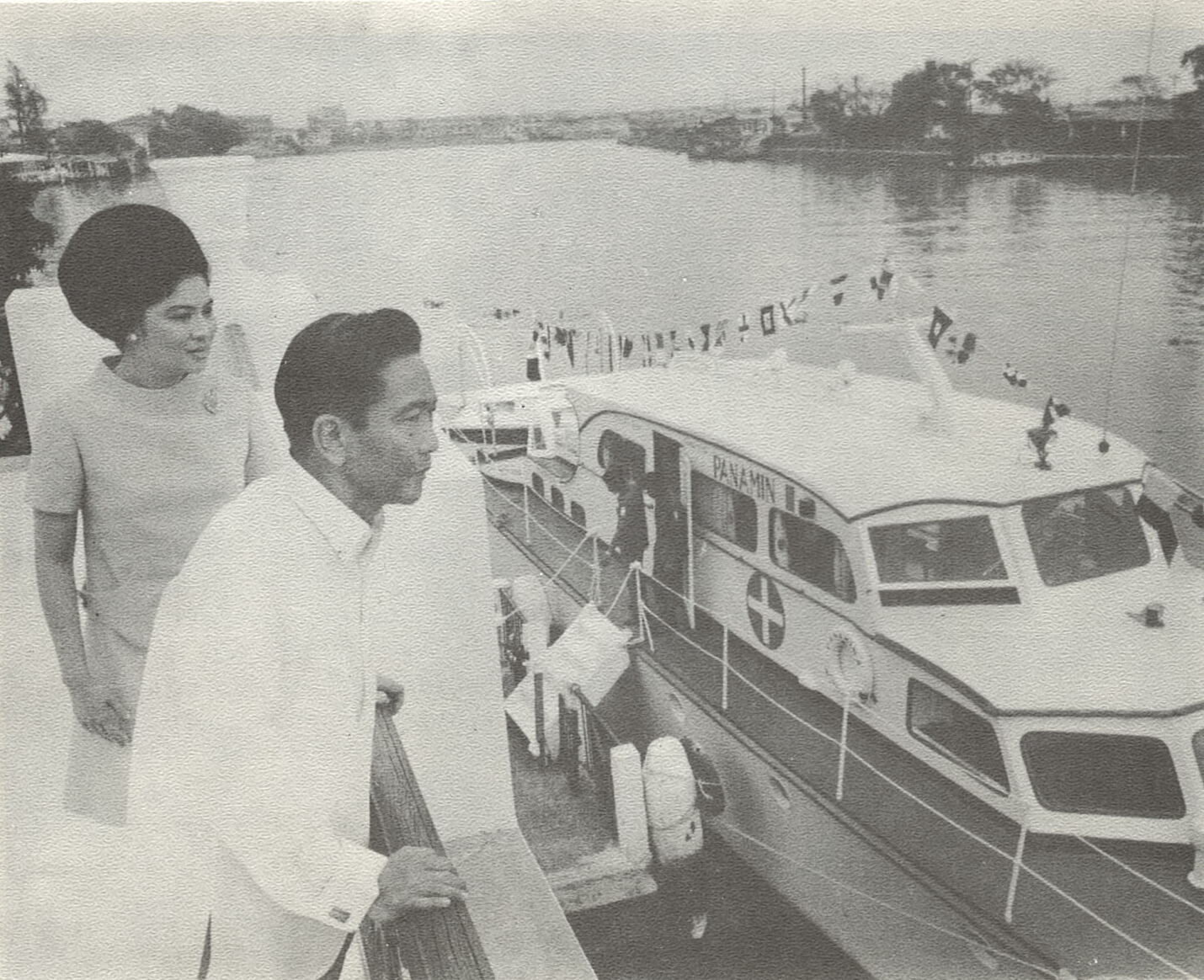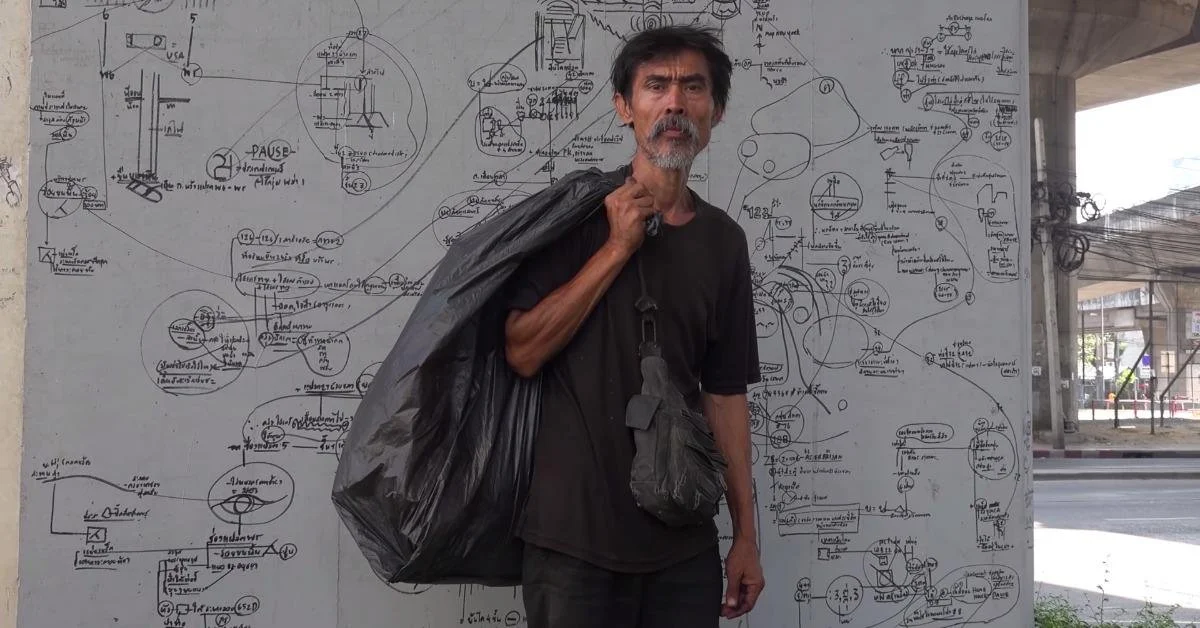Loneliness, Disappearance and the Veneer of Protection
The anxiety of disappearance informed the endeavors of two women who attempted to collect and protect tribal culture in Southeast Asia between 1960–1980. The first, Dorothy Pelzer (1915-1972), an American architect, who attempted to create an encyclopedia of architectural form in Southeast Asia (figure 1). The second, Filipino politician Imelda Marcos, who published books of folk history as part of a government scheme for the protection of Indigenous peoples (figure 2).
Figure 1. Dorothy Pelzer palay pounding in Apayao, Luzon, May 1968. Courtesy of: National Anthropological Archives, Smithsonian Institution [item: 1806-38] and ISEAS-Yusof Ishak Institute, Singapore.
In November 1969, amid finalizing drafts of her book Houses Are People, Dorothy Pelzer called her friend, the Malaysian architect Lim Chong Keat, from her home in the Cameron Highlands: “Chong Keat, can I come to see you…I’m desperately lonely. Do you have a recording of Bartok’s Romanian Folk Dances I can listen to with you?”[1] Pelzer’s loneliness echoed the subject of her book.
Between 1962 and 1972, Pelzer catalogued the slow disappearance of traditional house forms in Southeast Asia, whether nipa palm fronds woven into wall panels in the Filipino bahay kubo, or the densely thatched roof of the ravi in Papua New Guinea. Pelzer’s project was meticulous and relentless. “Village forms, structure, use of materials, roof shapes, planning, privacy, decoration, prefabrication, expressive significance and various non-functional factors such as orientation and symbolism” all contributed to her sprawling project.[2] Pelzer never finished Houses Are People—she died from cancer in April 1972—but perhaps she saw herself in the figure of Bela Bartok: an observer, a recorder, a translator of something that was disappearing. When Bartok lugged a phonograph around remote Romanian villages to record folk songs in 1918, it was because he asserted that peasants were “under the influence of urban culture [and had] given up their old customs and the corresponding ceremonies.”[3]
Figure 2. Imelda Marcos visiting a T’boli village in Cotabato, ca. 1970. Source: Ileana Maramag (ed.), Imelda Marcos Action Programmes (1973).
Although not an architect, Imelda Marcos, during her husband’s twenty-one-year dictatorship, was Minister of Human Settlements and exerted unparalleled influence on architecture. Marcos notoriously pushed building projects to completion at a frightening speed.[4]
The projects of both Pelzer and Marcos employed a similar rhetoric for describing the urgency with which to protect Indigenous peoples. The results, however, could not have been more different. While one project consumed its author, the other consumed its subjects.
Houses Are People would have been the first survey of its kind of traditional architectural types in Southeast Asia. In a draft of the introduction Pelzer wrote:
Virtually nothing has been done before in documenting this subject. The “big things” in Asian architecture—the temples and the tombs—are well documented. But of folk architecture—houses—there is very little record […] almost nothing interpreted from an architectural standpoint, and certainly nothing like a comparative study across the area as a whole, and [the urge to document] was due to a mental climate fast abandoning old forms in the rush for imported “progress”.[5]
The project was Pelzer’s life’s work, and her efforts were testimony to the book’s scale: she spent eight years trekking, scrambling and hitchhiking through mountainous, remote regions to document what she called “house forms” in Thailand, Malaysia, Burma, Borneo, the Philippines and Laos (where she worked for the U.S. Peace Corps in the 1960s) (figure 3). She knew the rugged terrain of Sumatra, Kalimantan and Sulawesi so well that she wrote a book about how to hike it, called Trek Across Indonesia.[6] Her frequent correspondences with her friends Bernard and Berta Rudofsky, who were traveling through Japan on a Fulbright Fellowship at the time, describe a project that was expansive and comprehensive; exhausting and isolating.[7] She took over 15,000 monochrome photographs, 7,000 slides and filled six filing cabinet drawers with notes and paraphernalia. The copiousness with which she collected and documented spun out of control as the project oscillated across territory, spilling over language barriers.
Figure 3. Dorothy Pelzer Isneg House, Apayao, Luzon, May 1968. Courtesy of: National Anthropological Archives, Smithsonian Institution [item: 1806 - 7] and ISEAS-Yusof Ishak Institute, Singapore.
The fastidiousness with which she attended her project is perhaps more indicative of encroaching modernity and loss of traditional ways of life than merely a desire for architectural comparison. The 1950s and 60s were the decades of massive infrastructural interventions in rural Southeast Asia. Globally, the World Bank was funding an average of a thousand high dams each year.
It is unclear whether Dorothy Pelzer ever met anyone from the Philippine government’s Presidential Assistant on National Minorities, though a scribbled down “PANAMIN” address is in her 1968 Manila diary. The agency was created a year prior with the task of protecting tribal minorities amid the government’s development agenda. One of PANAMIN’s sub-agencies was the Rehabilitation and Development Commission, of which Imelda Marcos was chair, and her work forms this story’s second vignette. It was a form of “cultural consolidation,” collapsing Indigenous people’s folk history into compact nationalist propaganda, while relocating them to reservations and resettlement centers (figure 4).
Figure 4. “From Malacañang terrace, President and Mrs. Marcos view PANAMIN floating clinic which serves ethnic groups in Mindanao,” ca. 1970. Source: Ileana Maramag (ed.), Imelda Marcos Action Programmes (1973).
The “Land and People Project,” spearheaded by Marcos, released a series of four publications in 1980 that attempted to describe the history of the Indigenous peoples of Mindanao in the southern Philippines. The titles of each of the books draws on folk motifs from the particular region of Mindanao they describe:
Bagani: Man of Dignity
Darangen: Epic of History
Linibung: Spiritual Longing for Immortality
Haylaya: Celebration After Spiritual Renewal
And the content of each volume follows a similar template: geographic landscape, ethnographic profile, tradition in the face of Spanish and American colonization, and present-day concerns. The final part of each volume focuses on the “travails of survival and what the future holds for them […] the evolution of the role tradition plays in modern life and how the new thrust of technological growth and modernization affects the value of tradition itself.” This is where it gets complicated. How would the inevitable “thrust” of technological growth affect tradition? Marcos continues in tones sliding between patriotic and patronizing:
The regional structure [is] a viable mechanism for development purposes, a means of creating an identity, a sense of destiny for a geographic area on the basis of its role or place in a new socio-political order, a new society that is being shaped for the entire archipelago.
Time was running out for tradition. The Marcosian “New Society” involved massive development projects across the country. This meant that tradition would somehow have to be consolidated within the framework of agribusiness, logging, monocrop planting and mining. “Development proceeds with a future perspective,” wrote Marcos in the preface to each edition of the Land and People books, “yet, history and tradition can set the basis for the pace, the quality and the direction of such development […] this is the overriding motivation behind this interest to start a tradition of historical literature on the land and people of each region of our country.”[8]
History and tradition were far from setting the pace. Shortly after its publication in 1980, villagers in T’boli—the region of Mindanao described in Bagani—had fled their homes after sustained government shelling. Cultural protection was more than simply a matter of documentation for groups like the T’boli that sat on resource-rich ancestral lands. An investigative team reported that the army claimed their men were only “testing artillery” aimed at the communist guerrilla New People’s Army (NPA) hideouts, but the T’boli believed the shelling was “intended to make them leave their homes and thereby pave the way for the operation of a pineapple and asparagus plantation,” owned by the American fruit company, Dole.[9] By 1980 the remote environments that formed the archives from which Pelzer and Rudofsky drew their evidence were changing. Not only was environmental degradation caused by infrastructural works and extractive schemes taking its toll, but Indigenous peoples had either been incorporated into counterinsurgency schemes or were caught in the crossfire of government anti-communist military maneuvers.[10]
Like environmental degradation, cultural extinction was human-induced, and commentators were beginning to draw parallels between ecocide and ethnocide. In 1981 UNESCO issued a statement defining ethnocide as when “an ethnic group is denied the right to enjoy, develop and transmit its own culture and its own language, whether collectively or individually.” Yet it took time to develop a language for cultural preservation. The vignettes of Pelzer and Marcos reveal how architectural taxonomy and tribal objectification are aspects of a similar, seemingly benevolent gaze that can be employed to different ends. In the time between them, a sinister shadow fell between the veneer of protection and the politics of displacement, and both figures in this story provide ways to study the extreme ends of this dichotomy. Pelzer, like Rudofsky or Bartok, was a self-appointed prefect of culture whose intrepid mission was interminable and encyclopedic. Marcos was a meddling lowlander who, through a form of tribal necropolitics, contained culture—literally in books and physically in reservations constructed for Indigenous peoples displaced by surreptitious land-grabbing. Yet the disparity between these examples is evidence of how culture can function as architectural evidence. Advocacy can be a pernicious activity: if tradition can be categorized, so too can it be removed.
NOTES
[1] Recorded in personal interview with Lim Chong Keat, May 2018. Pelzer met the Malaysian architect Lim Chong Keat during their studies at MIT in 1950. My thanks go out to Dell Upton, Jiat-Hwee Chang and Lim Chong Keat for arranging a productive visit in Penang. Thanks to the staff at the Center for Third World Studies at UP Diliman, Quezon City for their ever-productive questions and suggestions. Thanks also to the Anne Greenwald Travel Fellowship through UCLA that provided the funds to make the visit possible.
[2] Ong Choo Suat, Biography of Dorothy Pelzer, Southeast Asian Cultural Research Project (SEACURP, Singapore, 1982), 6.
[3] He would later transcribe these pieces as the Romanian Folk Dances (Magyarországi román népi táncok). Béla Bartók, The Hungarian Folk Song (SUNY Press, 1980), 10.
[4] In addition to being Minister of Human Settlements, (MHS), Imelda Marcos was also head of the Metro Manila Development Authority (MMDA). Both organizations were major forces for building and urban renewal in the capital during the Marcos dictatorship. Imelda Marcos commissioned and directed funds toward hundreds of built projects and was close friends and a patron of many of the country’s prolific architects, including Leandro Locsin, Juan Nakpil, Francisco Mañosa.
[5] Dorothy Pelzer, Houses Are People (Drafts), National Anthropological Archives, Smithsonian, Washington D.C.
[6] Dorothy Pelzer, Trek across Indonesia (Singapore: Graham Brash, 1982).
[7] This was for research toward his book on Japan: Bernard Rudofsky, The Kimono Mind: An Informal Guide to Japan and the Japanese (London: V. Gollancz, 1965).
[8] Bagani: Man of Dignity (Presidential Commission for the Rehabilitation and Development of Southern Philippines, 1980).
[9] The authors of Ethnocide: Is It Real? assert that ethnocide is a colonial legacy, an effect of “development aggression” that is only controversial as a term due to the “visions of widespread loss of culture and ethnic identity among the estimated 2.3 million Indigenous members in Mindanao.” Ethnocide: Is It Real? (Davao City, Philippines: Media Mindanao News Service, 1993), 3.
[10] Incorporating Indigenous peoples into international wars to be used for their local knowledge has a long history. In Southeast Asia, the Montagnards of the Vietnamese highlands were infamously used by the U.S. Army’s Montagnard Program. Many groups of Indigenous peoples have been affected by the Philippine Army’s anti-insurgency tactics, both before, during and after the Marcos dictatorship. Some key insights are published in Tribal People and the Marcos Regime: Cultural Genocide in the Philippines (Berkeley: Southeast Asia Resource Center, 1979).







